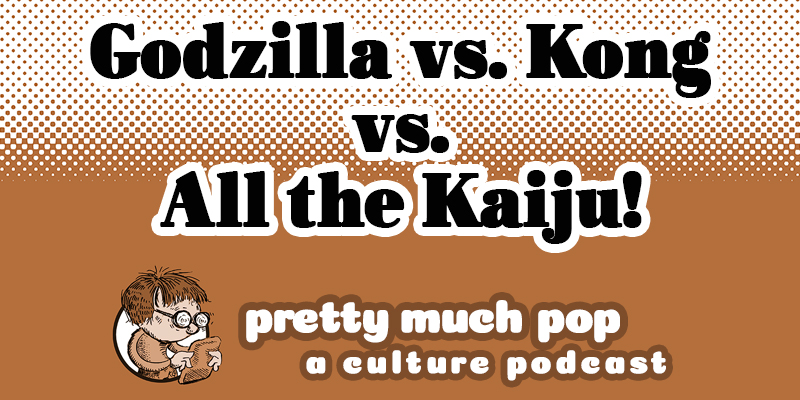
What’s the meaning behind the continued international popularity of kaiju media in which giant creatures stomp on cities and beat each other up? Is this just pro wrestling drama with special effects, or does it relate to deep-seated feelings of helplessness in the face of natural disasters? Perhaps both?
Your Pretty Much Pop hosts Mark Linsenmayer, Erica Spyres, and Brian Hirt reflect on the MonsterVerse films: Godzilla (2014), Kong: Skull Island (2017), Godzilla: King of the Monsters (2019), and chiefly Godzilla vs. Kong (2021). We also go into the history of Godzilla in Japan from the 1954 original to 2016’s award-winning Shin Godzilla. Do we care at all about the humans in these films? Are King Kong films too sad? Is there any legitimate sci-fi or political commentary in this genre? We touch on Pacific Rim, The Host, Cloverfield, Colossal, When a Monster Calls, Rampage, giant video game bosses, and more.
Some sources we used to prepare:
- “‘Godzilla vs. Kong’ Raises the Question: Is Nonsense the New Normal?” by Owen Gleiberman
- “Godzilla vs Kong Suggests KOTM’s Villains Were Right” by Nicholas Raymond
- “Shin Godzilla Made Its Kaiju Monstrous Again” by Darren Mooney
- “10 Monsters Godzilla Should Fight Next” by Matthew Chernov
- “15 Best Kaiju Movies That Don’t Star Godzilla” by Patrick Leigh
- “The Top 21 Most Kick-Ass Giant Monsters in Movie History!” by Brian Solomon
- “MST3K: A Guide to the Giant Monster Movies of Mystery Science Theater 3000″ by Gavin Jasper
- “The History of Godzilla (1954)” the beginning of a great YouTube series by Big Action Bill
Plus, here’s more on The Great Buddha Arrival and Wolfman vs. Godzilla.
Hear more of this podcast at prettymuchpop.com. This episode includes bonus discussion that you can access by supporting the podcast at patreon.com/prettymuchpop. This podcast is part of the Partially Examined Life podcast network.
Pretty Much Pop: A Culture Podcast is the first podcast curated by Open Culture. Browse all Pretty Much Pop posts.

